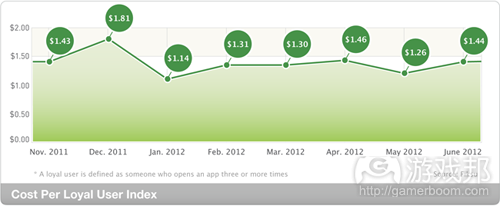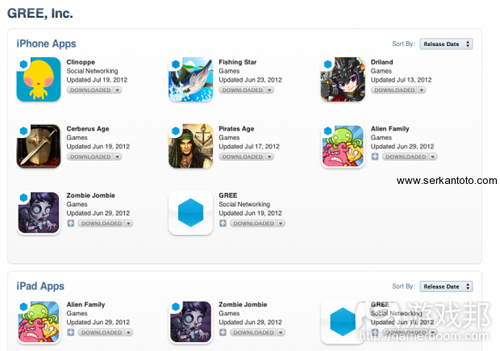每日观察:关注GREE“日本制造”游戏在美国市场表现(8.1)
1)Fisku最新报告显示,6月份iOS应用下载量增长缓慢,但忠实用户(至少三次开启应用的用户)获取成本却迅速上涨。
该时期美国前200名免费iPhone应用日均下载量为463万次,略高于5月份时的454万次日均下载量。这一水平低于1月份时的679万次日均下载量,因为当时有不少开发者、发行商采用违规程序提升下载量,苹果在2月份采取措施制裁这种现象,因此iOS应用日均下载量连续三个月出现下滑趋势。
与此同时,iOS忠实用户获取成本则从5月份的1.26美元增长至1.44美元,增幅为14.3%。Fisku认为这一结果主要归咎于季末营销成本增长,以及UDID属性追踪工具受限这两个因素。
2)消费者电子协会(Consumer Electronics Association,简称CEA)第二季度数据显示,29%美国网络用户已拥有平板电脑,这一数据比第一季度增长9%。
有三分之二用户有意购买平板电脑,有45%用户打算在两年内购买平板电脑。
用户最常在平板电脑上从事的活动是看电视,其次是登陆社交网络,第三是听音乐,第四是看书。
3)dealchecker.co.uk最近调查结果显示,越来越多用户通过智能手机、平板电脑预订和安排自己的假期。7月份其网站每8名访客中就有一者来自移动设备,其移动访问用户在6个月内增长94%。
有49%移动用户通过iPad访问该网站,苹果用户在所有访客中占比82%,Android用户占比14%,黑莓用户占比3%。
4)据insidemobileapps报道,谷歌日前向Android开发者发送邮件宣布Google Play政策进行了相关调整,其中影响最为重大的是要求开发者采用Google Play官方支付系统,不再支持PayPal、Boku或BoxPay等第三方Android支付服务。
开发者还有30天时间调整自己的应用支付系统,但向Google Play提交的新应用则需立即遵守这一新政策,否则将以违规之名被Google Play移除。
除此之外,Google Play新政策还将禁止开发者“采用欺骗性的应用名称以及发送垃圾信息”。即日起谷歌将限制开发者采用与Google Play其他现存应用类似的应用名称和图标,不允许应用在未经许可的情况下向用户发送短信或邮件。另外,Google Play开发者还必须明确应用中的广告或通知信息的来源,允许用户跳过广告(不可强制用户在与广告互动之后才能访问应用)。
5)EA日前公布其2013财年第一季度报告指出,该时期EA移动业务净收益为6900万美元,同比上季度下降20.6%,但同比上年增长21%。公司数字业务总收益为3.24亿美元,其中移动业务收益占比21.3%(2012财年第四季度占比20.2%)。
EA在这一季度的总收入为9.55亿美元,其中移动业务占比7.2%(上一季度占比6%)。
EA免费增值游戏业务(包括社交游戏)目前每周收益为630万美元,比去年同期增长152%(2012财年第一季度该业务每周收益为250万美元)。
EA PopCap作品《宝石迷阵闪电战》仍是公司头号热门手机游戏,此外公司数字平台Origin在移动领域也收获900万注册用户。
该时期EA基于GAAP的净收益为2.01亿美元,比去年同期的2.21亿美元下降9.9%,预计第二季度的GAAP净收益为6.5亿至7亿美元,整个2013财年数字业务收益将达15亿至15.5亿美元。
EA财报公布后该公司股票上涨1.36%,每股售价为11.17美元。
6)据Serkantoto报道,尽管GREE顺利展开其全球发展战略,但该公司的“日本制造”游戏在美国表现并不理想。据App Annie数据显示,GREE目前已在App Store发行92款应用,非除日语版应用,GREE在美国App Store共有7款英文版应用(游戏邦注:其中一些游戏目前仅投入加拿大市场,这个数据排除了Funzio旗下游戏)。
GREE于6月1日向美国App Store推出的《Driland》(Tanken Doliand)在免费应用榜单最高排名是499名(6月15日排名情况),在营收应用榜单却从未跻身前1000名。
6月12日登陆美国App Store的《Fishing Star》在免费应用榜单最高排名仅816名(6月24日排名情况)。
而主要在美国开发,并投入大量营销成本的GREE游戏表现却可圈可点,例如《Alien Family》(首发于3月22日)在美国App Store免费应用榜单最高排名是第3名(3月31日排名情况),在营收榜单最高排名是94名(4月1日排名情况);《Zombie Jombie》(首发于3月14日)在免费应用榜单最高名次是第5名(3月17日排名情况),在营收榜单最高名次是第7名(3月18日排名情况)。(本文为游戏邦/gamerboom.com编译,拒绝任何不保留版权的转载,如需转载请联系:游戏邦)
1)Fiksu: user acquisition costs rise dramatically while iOS downloads see minor increase
Kathleen De Vere
iOS download volume is slowly rising again but user acquisition costs are rising faster, reports user acquisition company Fisku. The cost to acquire a loyal user — defined as someone who will open an app at least three times — jumped by 14.3 percent to $1.44 per loyal user in June.
While Fisku attributed the increase to quarter-end marketing spends and a cautious return to UDID (Unique Device Identifier) attribution tracking, we’ve heard from several sources that user acquisition costs have risen dramatically as some well-funded players have started to compete in earnest for new users. This has not just lead to an increase in user acquisition costs, but has also been responsible for the sudden push to form new mobile cross-promotion networks — an alternative (and much, much cheaper) way to acquire new users.
iOS downloads also rose in June, hitting 4.63 million daily downloads spread between the top 200 free iPhone apps in the U.S. — a slight gain over May’s average of 4.54 million downloads.
While daily download volume is still down from January’s all-time high of 6.79 million downloads, that peak was inflated by the use of download bots, a chart-gaming tactic used by some developers to artificially push an app to the top of the free charts. Apple’s crackdown on the practice in February caused the volume of daily app downloads to fall for three straight months.(source:insidemobileapps)
2)CEA: 29 per cent of online Americans own a tablet
by Zen Terrelonge
And 45 per cent expect to buy one in the next two years.
New Q2 data from the Consumer Electronics Association shows 29 per cent of online US consumers now own a tablet, a nine per cent increase on Q1, while global sales for the year are set to hit 68.5m.
Two-thirds plan to buy a tablet in the future, with 45 per cent to purchase one within two years.
Shipment revs are expected to reach $29.1 billion this year, $11bn more than originally thought in January, and the CEA claims this will push the consumer electronics industry revs across $200bn for the first time.
Kevin Tillmann, senior research analyst, CEA, said: “The overall market for tablets continues to grow significantly with household penetration increasing for the foreseeable future.
“Rarely has a new device category been so quickly embraced by consumers, businesses and education.”
Viewing films is the most common use for tablet owners, with social networking in second, music in third, and book reading in fourth.(source:mobile-ent)
3)49 per cent of all mobile visitors to holiday site are using iPad
by Mike Shaw
Huge increase in people looking for cheap holidays via smartphone.
Price comparison site dealchecker.co.uk has received their highest ever number of mobile visitors, as more people turn to smartphones and tablet computers to book and plan their holidays.
In July, nearly one in eight visitors accessed the site from a mobile device – a 94 per cent increase in mobile visitors in just six months.
Forty-nine per cent of mobile users visited the site via iPad, with Apple users making up 82 per cent of all visitors. Android accounted for 14 per cent with BlackBerry bringing up the rear at three per cent.
Mark Attwell, MD of dealchecker.co.uk, said: “Smartphones and tablets offer help at every stage of a trip, from research to finding cheap holiday deals to sharing pictures and problem solving on the road.”(source:mobile-ent)
4)Google drops the hammer on third-party Android billing services, apps must use Google’s billing system
Kathleen De Vere
It appears Google is finally putting its foot down when it comes to third-party payment processing in its official app store — the company has sent out an email to Android developers outlining several updates to the Google Play program policy, including a small but significant update to its payment policies.
“We’re making it explicit for applications and in-app purchases that developers are required to use the Google Play payment system,” said Chris Yerga, engineering director for Google Play when asked about the changes.
Although Yerga points out that Google will still make exceptions for apps that sell physical goods or services such as movie tickets, developers of most apps will now have to use Google’s official channels, rather than alternative payment providers like PayPal, Boku or BoxPay.
Developers will have 30 days to bring their existing apps into compliance, but new applications submitted to Google Play will be subject to Google’s new policies immediately. Apps that don’t comply will be subject to removal from the Google Play store, just like any other app that Google finds to be in violation of its terms of service, says Yerga.
Although Google has always mandated the use of its official Google Wallet payment system, the company hasn’t always been strict about enforcing the policy.
“We actually have been enforcing our payments around payments historically, but there’s been certain exceptions,” explains Yerga. “Before we had subscriptions, if someone was dependent on an application that required subscriptions, we were a little more lenient. Here we want to make things explicit about what’s included and what’s not included. The baseline default is we require applications to use the Google payment system.”
Today’s announcement isn’t likely to surprise many Android developers. Reuters reported Google was looking to take a more strict approach to enforcing payment standard back in March, stating several developers had been warned about their continued use of third-party payment providers. At the time Google denied the report, telling TechCrunch it hadn’t changed its policies, and saying the whole story was a “non-starter.”(source:insidemobileapps)
New Google Play developer policies prohibit spammy apps, invasive advertising
Kathleen De Vere
Google is cleaning up the official Google Play store a bit, making several changes to its Developer Program policy to improve its user experience and address issues like “deceptive app names and spammy notifications.” In an email sent out today to Google Play developers, the company outlined several new changes to its policies.
From now on, Google will restrict the use of app names and icons that it deems too similar to existing system apps. These apps typically attempt to confuse or misdirect users by purporting to be an official, pre-installed application, rather than something the user downloaded themselves.
Google is also making its policies about collecting user data clearer. The new policies explicitly prohibit the collection of user data without permission, and require developers to specifically outline what user data they are collecting. Apps are now expressly prohibited from sending SMS or email messages on behalf of a user without permission.
One of the most significant changes, however, is a new section dedicated to the Google Play ad policy. It’s now clear that Google considers the ads in an app part of that app, meaning all of Google’s policies around content and data collection apply just as much to the ads an app show to the app itself. In addition, Google Play developers must now make it clear what app an ad or a notification originates from. Users must also be allowed to dismiss an ad without penalty, and ad walls — advertisements a user must interact with in order to gain access to an app — are now expressly prohibited.
In the past Google has been criticized for what some see as relatively lax quality controls in Google Play. Google does not pre-screen or censor apps before they appear in the Google Play store, a policy that some unscrupulous developers have taken advantage of.
Earlier this month mobile security company Lookout reported almost five percent of all apps use “aggressive ad networks” — ad providers that access personal information such as email without notifying the user, change a user’s bookmarks or settings without asking permission or even serve ads outside the app they are connected to. Today’s changes to Google’s Developer Program seem to be aimed squarely at those kinds of apps.
“The way I think about it is the apps and Google Play itself are evolving,” says Chris Yerga, engineering director for Google Play. “What we’re trying to do here is give developers very concrete guidance about what’s expected of them.”
In addition to the changes noted above, apps with the primary function of driving affiliate traffic to a website, or load websites that don’t belong to the application developer (unless they have permission from the website’s owner/administrator) are now prohibited. Apps that encourage users to download applications from outside the Google Play store are also banned under the new guidelines.(source:insidemobileapps)
5)Electronic Arts mobile revenue drops to $69M in Q1
Kathleen De Vere
Electronic Arts’ mobile net revenues for Q1 2013 were $69 million dollars, a drop of 20.6 percent quarter-over-quarter, but a gain of 21 percent year-over-year. It is the first time since Q2 2012 that the company hadn’t seen its mobile revenues increase on a quarterly basis.
Although down quarter-over-quarter, EA’s mobile revenues accounted for a larger portion of the company’s overall revenues in Q1 2013 than they did in Q4 2012. Mobile revenues accounted for 21.3 percent of the company’s total digital revenues of $324 million, up from the 20.2 percent of digital revenues they accounted for in Q4. Q1 2013 mobile revenues were 7.2 percent of the company’s overall earnings of $955 million, up from 6 percent in Q4 2012.
On a non-GAAP (generally accepted accounting principles) basis, EA’s smartphone and tablet revenues grew 86 percent year-over-year to $52 million. As predicted, the company’s feature phone revenues fell, dropping 13 percent year-over-year to $27 million. On a non-GAAP basis, mobile phone and tablet earnings increased by 37 percent year-over-year. Overall smartphone and tablet revenues were $201 million on a trailing 12 month basis.
EA also highlighted the growth of its free-to-play business, which includes social games, FIFA Online, EA’s mobile and tablet titles and well as offerings on its Play4Free.com website.
Overall the company is now seeing $6.3 million in weekly free-to-play revenue, up 152 percent year-over-year, from the $2.5 million a week the company was earning in Q1 2012.
Once again, EA PopCap’s bejeweled Blitz was the company’s top performing mobile game. The company’s Origin services also did well on mobile, with 9 million registered mobile users.
EA’s GAAP net income for Q1 2013 was $201 million, down 9.9 percent year-over-year from Q1 2012’s $221 million. The company is predicting GAAP net revenues of $650 to $700 million for Q2 2013, and digital revenues somewhere between $1.5 and $1.55 billion for the 2013 fiscal year.
The company’s shares were up slightly on the news, rising 1.36 percent in after-hours trading to $11.17 each.(source:insidemobileapps)
6)Q: Are GREE’s Japanese Games Successful In The US So Far? A: Not At All. [Social Games]
by Dr. Serkan Toto
I summarized my personal prediction on both GREE‘s and DeNA‘s chances of becoming the leading platform providers for mobile social games in the US (and globally) back in March.
I was actually pessimistic in September 2011 already. In fact, I was pessimistic since I first started thinking about it.
I can only stress that I hope I will be proven wrong eventually: after all, Japanese mobile and social games are my main area of business. I want to see both DeNA and GREE succeed. I think these are great companies, and it would be in my own best interest to see them succeed outside this country.
But I can say with confidence I am too honest to keep my thoughts to myself and paint a rosy picture just to get consulting gigs (I mean in general: consulting to GREE and DeNA has always been absolutely out of the question for me anyway for a number of reasons).
After flattering myself, here is a look at the status quo of GREE’s plan to bring their platform and games to the US (the first and certainly most important target market outside Japan).
On the platform side, GREE started their offering in English in May this year. Personally, I was disappointed by it for a few reasons, even when taking into account the beta moniker.
But that may just be me, and all of the above is pretty subjective. The good thing is that Apple and Google allow everybody to look at the games themselves in a quantitative way (it’s harder in Japan where the browser is still king for social game distribution).
To keep things simple (and as concise as possible), I focus on the performance of GREE’s games in the App Store in the US only, using analytics platform App Annie.
I believe this is fair, as
•GREE’s global platform started on both iOS and Android at the same time
•10 weeks have passed since launch
•all of GREE’s games outside Japan are offered as apps (not mainly through the browser, as in Japan)
So how do things look at this point?
In one word: bad.
According to App Annie, GREE, Inc. published 92 apps in the App Store so far (list). Taking out the Japanese apps, GREE currently offers 7 apps in English in the US App Store (some games are only available in Canada, for example, and I am not counting Funzio’s titles).
This is what the US App Store shows for GREE, Inc.:
Here’s how they performed so far:
Game 1: Driland / Tanken Doliland in Japan (initial release in the US: June 1, 2012)
highest position in the ranking of free apps in the US App Store so far:
#499 (reached on June 15, 2012)
highest position in the ranking of top grossing apps:
- (the game never made it into the ranking/top 1,000)
Game 2: Pirates Age (initial release: May 15, 2012)
highest position in the ranking of free apps in the US App Store so far:
-
highest position in the ranking of top grossing apps:
-
Game 3: Clinoppe (initial release: June 28, 2012)
highest position in the ranking of free apps in the US App Store so far:
-
highest position in the ranking of top grossing apps:
-
Game 4: Fishing Star (initial release: June 12, 2012)
highest position in the ranking of free apps in the US App Store so far:
#816 (on June 24, 2012)
highest position in the ranking of top grossing apps:
-
Game 5: Cerberus Age (initial release: May 23, 2012)
highest position in the ranking of free apps in the US App Store so far:
-
highest position in the ranking of top grossing apps:
-
To make things complete, here are the games that were mainly developed by GREE in the US – and pushed by an undisclosed but undoubtedly high amount of marketing dollars (here’s just one pointer).
Game: Alien Family (initial release: March 22, 2012)
highest position in the ranking of free apps in the US App Store so far:
#3 (on March 31, 2012)
highest position in the ranking of top grossing apps:
#94 (on April 1, 2012)
Game: Zombie Jombie (initial release: March 14, 2012)
highest position in the ranking of free apps in the US App Store so far:
#5 (on March 17, 2012)
highest position in the ranking of top grossing apps:
#7 (on May 18, 2012)
I think with 3 of 5 made-in-Japan games not even making it into the top 1,000 in the American App Store, GREE’s numbers so far speak for themselves. The reaction in the industry in the US to GREE’s initial batch of Japanese games like Driland was disastrous. Worse: a lot of English-language gaming news outlets don’t even bother with GREE’s offering at all.
Now I just hope GREE has a very, very good plan B and that there are some real killer titles in the pipeline for the next months.(source:serkantoto)





























.png)
















 闽公网安备35020302001549号
闽公网安备35020302001549号